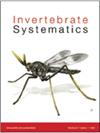两个管虫的故事:中开曼传播中心的管虫分类(环节动物:管虫科)
IF 1.9
2区 生物学
Q3 EVOLUTIONARY BIOLOGY
引用次数: 1
摘要
摘要腐虫管虫属Lamellibrachia和Escarpia栖息在以化学合成为基础的深海生态系统中,如渗漏、热液喷口和有机瀑布,分布在太平洋、大西洋和印度洋。2010-2012年,在开曼群岛中部扩展中心(MCSC)热液喷口的初步勘探过程中,发现这两个属共同出现在冯达姆喷口区(VDVF),该地区以扩散流为特征,因此类似于“热液渗漏”。在这里,我们从VDVF中建立了两个新的蜕皮虫管虫物种,Lamellibrachia judigobini sp.nov.和Escarpia tritantaculata sp.nov.Lamellibrachia judigobini sp.nov.在基因和形态上与其他Lamellibrahia物种不同,其范围遍及墨西哥湾、MCSC、特立尼达和多巴哥海域以及巴巴多斯,以及穿过通风口和渗漏以及964–3304米的水深。三齿Escarpia tritantaculata sp.nov.主要根据形态学与其他Escarpi亚物种区分开来,仅从2300m深的MCSC喷口中已知。这项研究强调了一个Lamellibrachia物种和Escarpia属令人难以置信的栖息地灵活性,以及L.judigobini sp.nov.与东太平洋和E.tritantaculata sp.nov.ZooBank:urn:lsid:ZooBank.org/pub:D9F72BD4-FDE1-4C0A-B84B-A08D06F2A981与东大西洋的历史生物地理学联系本文章由计算机程序翻译,如有差异,请以英文原文为准。
A tale of two tubeworms: taxonomy of vestimentiferans (Annelida: Siboglinidae) from the Mid-Cayman Spreading Centre
ABSTRACT The vestimentiferan tubeworm genera Lamellibrachia and Escarpia inhabit deep-sea chemosynthesis-based ecosystems, such as seeps, hydrothermal vents and organic falls, and have wide distributions across the Pacific, Atlantic and Indian Oceans. In 2010–2012 during initial explorations of hydrothermal vents of the Mid-Cayman Spreading Centre (MCSC), both genera were found to co-occur at the Von Damm Vent Field (VDVF), a site characterised by diffuse flow, therefore resembling a ‘hydrothermal seep’. Here, we erect two new vestimentiferan tubeworm species from the VDVF, Lamellibrachia judigobini sp. nov. and Escarpia tritentaculata sp. nov. Lamellibrachia judigobini sp. nov. differs genetically and morphologically from other Lamellibrachia species, and has a range that extends across the Gulf of Mexico, MCSC, off Trinidad and Tobago, and Barbados, and also across both vents and seeps and 964–3304-m water depth. Escarpia tritentaculata sp. nov. is distinguished from other Escarpia species primarily based on morphology and is known only from vents of the MCSC at 2300-m depth. This study highlights the incredible habitat flexibility of a single Lamellibrachia species and the genus Escarpia, and historic biogeographic connections to the eastern Pacific for L. judigobini sp. nov. and the eastern Atlantic for E. tritentaculata sp. nov. ZooBank: urn:lsid:zoobank.org:pub:D9F72BD4-FDE1-4C0A-B84B-A08D06F2A981
求助全文
通过发布文献求助,成功后即可免费获取论文全文。
去求助
来源期刊

Invertebrate Systematics
生物-动物学
CiteScore
4.30
自引率
9.10%
发文量
35
审稿时长
>12 weeks
期刊介绍:
Invertebrate Systematics (formerly known as Invertebrate Taxonomy) is an international journal publishing original and significant contributions on the systematics, phylogeny and biogeography of all invertebrate taxa. Articles in the journal provide comprehensive treatments of clearly defined taxonomic groups, often emphasising their biodiversity patterns and/or biological aspects. The journal also includes contributions on the systematics of selected species that are of particular conservation, economic, medical or veterinary importance.
Invertebrate Systematics is a vital resource globally for scientists, students, conservation biologists, environmental consultants and government policy advisors who are interested in terrestrial, freshwater and marine systems.
Invertebrate Systematics is published with the endorsement of the Commonwealth Scientific and Industrial Research Organisation (CSIRO) and the Australian Academy of Science.
 求助内容:
求助内容: 应助结果提醒方式:
应助结果提醒方式:


